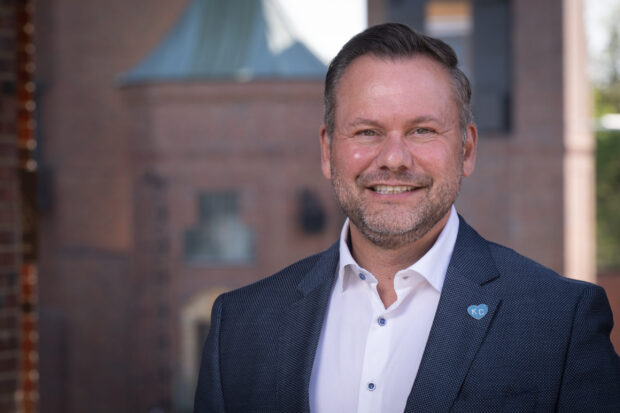HOME | ABOUT US | MEDIA KIT | CONTACT US | INQUIRE
HOME | ABOUT US | MEDIA KIT | CONTACT US | INQUIRE
At McCownGordon CONSTRUCTION, there’s far more To leadership than bumping the top line.

PUBLISHED APRIL 2025
Ramin Cherafat’s brand of leadership was forged in a crucible of family and fate, of loss and resolve. He wields it today as chief executive of McCownGordon Construction, the second-largest hometown general contractor, which he has well on its way to a long-held goal of becoming a national construction brand.
Since assuming command of the firm in 2018 following the retirements of founders Pat McCown and Brett Gordon, Cherafat has maintained an unwavering focus on organizational growth, on nurturing a unique corporate culture, and on a personal sense of engagement that is philanthropic, civic and sector-focused.
Those achievements earn him admission to Ingram’s 40 Under Forty Alumni of the Year club, now 10 strong, representing the pillars of Kansas City business.
Cherafat was influenced early in life by entrepreneurial spirit; his grandfather started a bank nearly a century ago, and his father followed in that line and with other ventures. Then came the Iranian Revolution in 1979. “In a matter of 24 months the family literally lost almost everything we had,” Cherafat recalls.
But there was an out: Even before that calamity, fate had dealt a hand when his father pursued collegiate studies at Washburn University—where he met his future wife and Ramin’s mother. They came to America, settled in Prairie Village (Cherafat’s mother was a KC-area native), and the path was set for a career.
Not, at first, in construction. “I wanted to be an orthopedic surgeon,” he says, mostly from personal experience: “I was pretty reckless as a kid. I broke 14 bones, and I was into mountain biking, skateboarding and all that kind of stuff.” Some of the perquisite science motivated him to reconsider pathways, and a fraternity brother majoring in construction science made a convincing pitch. Aspect of accounting, law and business, Cherafat says, “were a really good combination for me in terms of solving problems … and I was always intrigued with construction, being interested in how things got built. I feel so blessed that I fell into an industry that I absolutely love, even though I had no family ties to the business.”
His own leadership style starts with the fundamentals. “I’m very organized and detail-oriented,” Cherafat says. Early on, he commissioned a consultant’s nine-month exercise with more than a dozen hand-picked employees, members of the leadership team in up and coming roles. “We went through a process where we set a vision: What do we want our company to be known for in 20 years? Then we broke that down into components, but we had a big goal to be a nationally recognized construction company. I think my strength is always reminding everybody what that bigger picture is. People ask me all the time: ‘Well, gosh, you’ve got to spend so much time on strategy and this and that. But now I spend maybe 20 percent of my time on strategy and 80 percent on implementing that day-to-day.”
Before the leadership transition took place came a key bit of guidance. “One of the best pieces of advice I got from Pat McGowan as he was walking out the door, he looked at me and he said ‘Ramin, don’t ever forget how detailed this business is.” There are details and risks and that’s one of the things I love about this industry is construction companies are traditionally really well-disciplined companies, and have to be; we have really tight margins in our industry.”
His own background—from job-site to project management, COO and working with other members of the C-Suite, all of which punched his 40 Under Forty ticket in 2008—also paid off. “I think part of my biggest skill set is, I know the business,” he says. “I know how all the different facets work together from operations to the field operations to finance, marketing, business development and how all those work together to make sure the company keeps growing.”
The other essential component of the company’s success is what happens outside the office or off the job site. It has to do with culture, with engagement, with being a part of a community—first here in Kansas City, then in expansion markets like Dallas and Wichita.
“It definitely started with Pat and Brett; they deeply believed in giving back in the community, and I’m a huge believer in that,” Cherafat says. “It’s part of the DNA of our company. As we expand to other cities, community engagement and being involved is part of the business plan in each one of those markets.”
On a personal level, he enjoys the opportunities of service to connect with “really smart people. When you’re sitting at the table with other civic leaders and business leaders, one, it gives you great exposure to how other people think about problems, frame problems, and two, it also helped me understand that you always have to have a bigger thing that you’re shooting for to continue to keep growing, continue to keep advancing.”
To infuse those values into a culture, he says, “you have to walk the walk. The leader has to be committed to it, but you also have to show people that it’s a great way for them to develop and become great professionals. We encourage all of our executives and up-and-coming leaders to get involved in the community. It gives you good leadership experience. It helps build your network and it makes you more aware of what’s going on outside your company. You need to take a more global perspective on things rather than just always having your head down inside the company.”